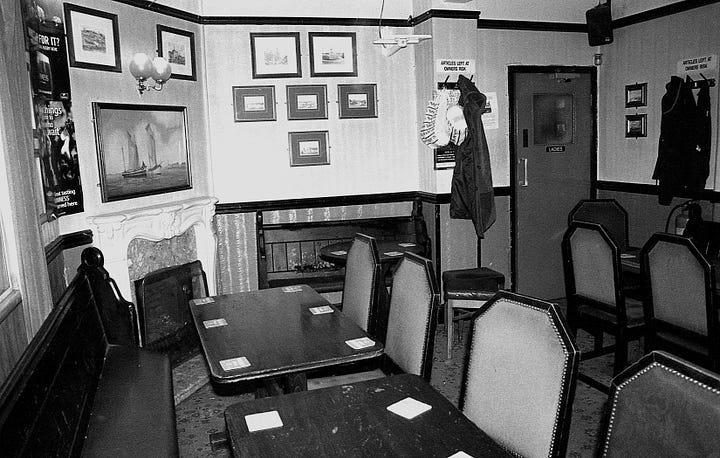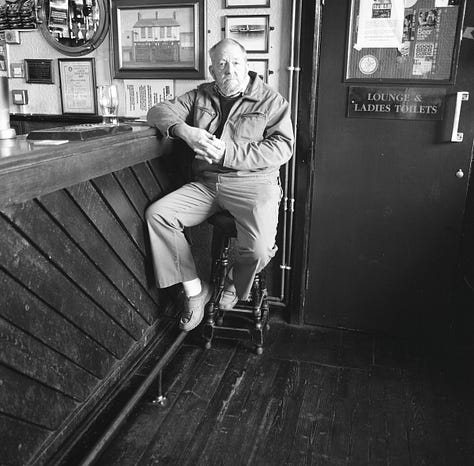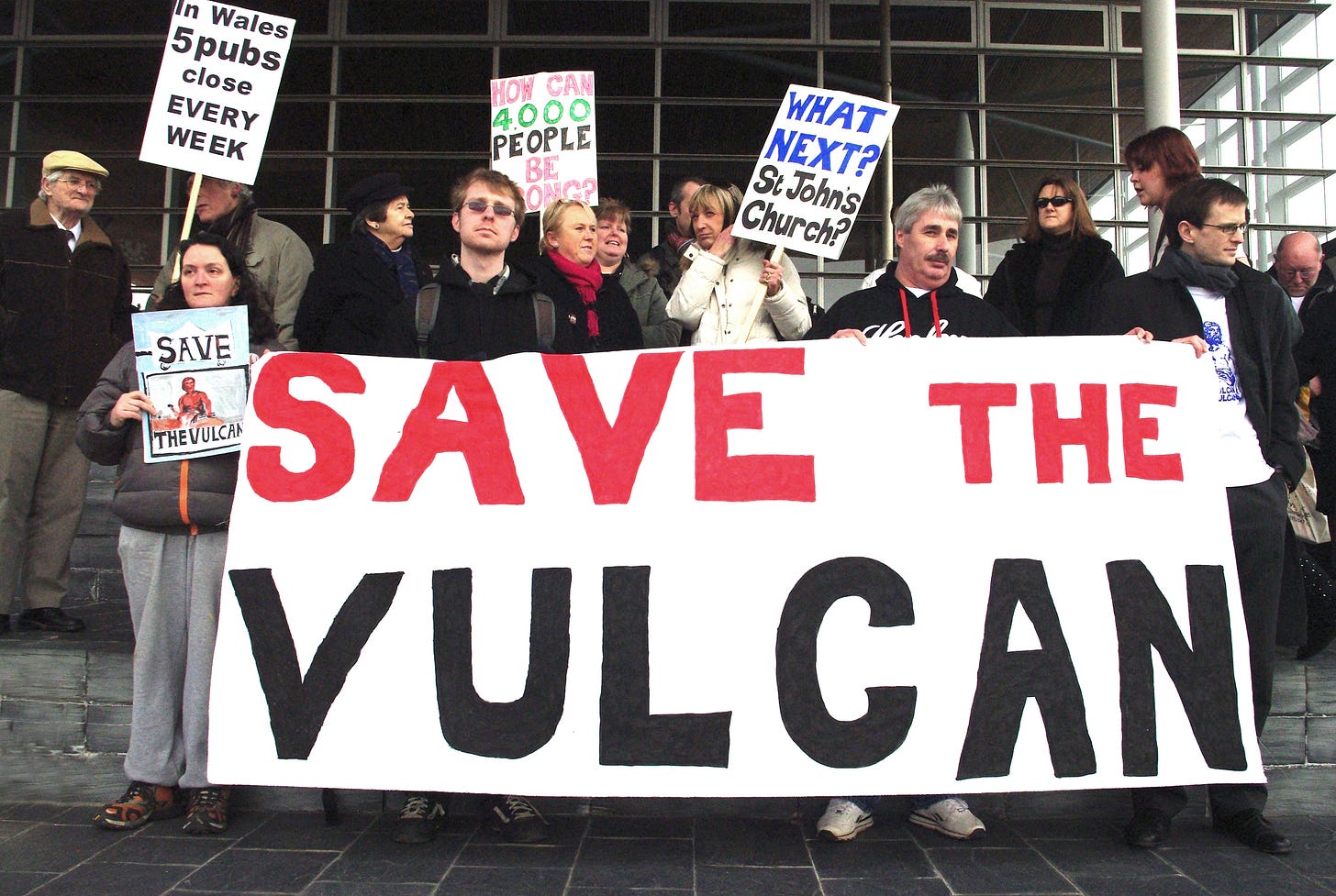The Vulcan breathes fire again
As Cardiff's most famous Victorian boozer reopens its doors at St Fagans museum, Peter Finch stands where once a working class community thrived
I am standing in the space where The Vulcan spent the last years of its trading life before being moved on to a bionic resurrection at St Fagans. Here with new mortar between its bricks and fresh rafters holding up a reslated roof it now lives a Trigger’s broom existence. Trigger, from Only Fools and Horses, was fond of his broom. This old broom has had 17 new heads, he would declare, and 14 new handles. Same broom. Of course it is.
The Vulcan void is now home to the NCP Adam Street Car Park. The cellar blocked by tarmac. The pub bar offering space enough for two SUVs, the Smoke Room another. Only the red GPO pillar box that stood slightly to the right of the entrance remains. All else gone.
The Vulcan opened back in 1853 when two terraced houses were knocked together to make one larger building. It was registered as The Vulcan Inn. It stood at the place where Adamsdown became Newtown, its location sufficiently ambiguous for arguments to break out as to which it was actually in. Both were walking suburbs of Cardiff’s booming industrial empire. Immediately to the south were the Dowlais steel works and beyond them the coal staithes that sent Cardiff’s black gold to the world. Turn right and you hit Bute’s West Dock, Cardiff’s first. Richard and Edward England’s potato importing business was at its head. There were canals, and trains and horses and trams.
Newtown was Cardiff’s Irish heartland populated by immigrants fleeing the potato famine in search of work and there was work in this town aplenty. Most of it filthy, all of it involving dust and hard labour. You sorted potatoes, you loaded coal, you tapped furnaces, you dug canals. You heaved, whipped, higgled, drew, carried and ported. And after a long and exhausting day breathing the smoke and smut polluted nineteenth century air you went to a tavern and sat in your most filthy of ragged clothes, unspeaking and facing fuggy space, to pour a pint of cool ale slowly down your throat.




The district – back-to-back terraces, insanitary, full of life – was erected by the second Marquis of Bute in 1846. It consisted of six streets, two hundred houses, and a church. St Pauls. That stood where the Central Link flyover today rises up from Adam Street. In addition to the Vulcan there were other pubs: The Crichton Arms, Tobins, The Cambridge, The Duke of Edinburgh. There were also shebeens, unlabelled but known about terraced house front rooms. This was where illegally stilled whiskey could be had for bargain prices. It offered a cheap, blinding fire that hit the spot in a way that measured beer never would.
Newtown led a rumbustious life which ended when the district was eventually slum cleared in the late 1960s and – despite plans and protestations to keep the community together – was dispersed to Pentrebane, Llanrumney and Ely winds.
The Vulcan was a formally licensed tavern. It offered lodgings on the first floor with drink in the bar and smoke room below. It was named after the Roman god of fire and metalworking – two things that went through the hands daily of many of the Vulcan’s drinkers. It was significantly remodelled in 1914-5 when the familiar green-tiled front was added and the building extended. It’s probable that the flamboyant ceramic gents urinals were added at this point. With a new face and new rooms to rent the pub upgraded its name to The Vulcan Hotel.
At the end of the twentieth century with Cardiff’s steelworks closed, its potato business shattered and coal unseen for decades the pub’s raison d’etre appeared to be gone. The district it served had been largely emptied leaving the Vulcan a lone survivor standing in the vast car park facing down the University of South Wales’ brand new atrium across the road. Who were the pub’s drinkers?









Not the students, not yet. For a time a bunch of writers met here. There are a few photos doing the rounds. In one, taken by Casnewydd maestro John Briggs, Ifor Thomas, Morgan Francis, Charlotte Greig, John Williams and I sit on green plastic chairs on the outside pavement. On other occasions the group might be joined by travel writer John Harrison, poet Grahame Davies, and novelists Sean Burke, Des Barrie and Rachel Trezise.
We’d discuss the ways of the world, the anguish of the planet, the success (or not) of the latest masterwork, the reach of financial aid, the appallingness of how the literary business manages its denizens and what books we might, or might not, be engaging with next. This kind of writer talk, filled not with how to break into the biz but how to manage once you have, went on sporadically at the Vulcan for a fair few years.

The writers had ended here on the whim of John Williams who had been driving a search for the gems of Cardiff’s drinking past for at least the last decade. The group had tried many, sought them out before they’d vanish. Pubs right across the inner city were (and still are) closing at a prodigious rate. The New Dock Tavern. The Cottage. The Canadian. The Criterion. The Locomotive. The Bertram. The Clifton. The Greyhound. The Blue Anchor. The Rose and Crown. The ones that had done time with sawdust on their floors, where tables and chairs were a rarity and beer came hand pumped from the cellar below. Most of the time the entire pub’s clientele would be smokers. A distinctive, grey fog would suffuse the establishments’ air.
By 2010 Vulcan owners, Brains, had decided that the towel needed to be thrown in. Turnover at The Vulcan was dropping. Closure was announced to be immediately followed by a vigorous popular campaign for the pub to remain open, although this would be destined to eventual failure as such things often are. A whole raft of the culturally famous turned out to give their support, people who’d never drunk here before but were willing to add their names to the cause as the culturally generous often do: John Cale, Manic Street Preachers, Neil Kinnock, Jenny Randerson, Rhys Ifans.
Attempts were made to get Cadw to list the building but Cadw were not interested. They would list, they said, a classic Victorian city pub from the 1850s but the early 1900s Vulcan refurb during which tiling was added, the bar extended and the urinals remodelled had significantly changed the building’s character. This was now an Edwardian pub and the city had plenty of those.
But instead, at the last moment, the cavalry arrived, as cavalries often do – although not usually in defence of public houses. St Fagans, the one-time folk museum, was set on diluting some of its farm implement, coracle collecting and country chapel folksiness. It was now looking at structures from Wales’ urban environment. The Museum already had a working men’s club, a terrace of workers’ houses and a prefab bungalow rescued from the Gabalfa estate. To complete the set they wanted a pub and The Vulcan was to be it. Arriving from left field in a blaze of inspired glory and at absolutely the right time they did a deal to save the pub for the nation.
In 2012 the building was taken down brick by brick. It has now, in 2024, been restored to its 1915 glory and stands in triumph near the Oakdale Workmen’s Institute in the grounds of the St Fagans National Museum of History to the west of the city. The Glamorgan Brewing Company who won the franchise for Vulcan alcohol supply offer three kinds of beer. All are available by the pint. The writers, the one time locals, and the cultural celebs need to queue with the hoi polloi for a table where they can quaff a beer flight. This consists three thirds of a pint of three different beers. £10 a go, table to be returned after an hour. It’s a victory, isn’t it?
Peter Finch is a full-time poet, psychogeographer, critic, author, rock fan and literary entrepreneur living in Cardiff, Wales. His books include the Real Cardiff series.








